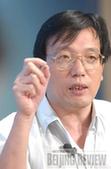|
 |
|
"The government should continue to make headway in reforming its policies to meet the new needs of industrial development." —LIU SHIJIN (CFP) |
The Chinese Government raised an 8-percent economic growth goal for this year amid the daunting challenges of the global economic crisis. Given the dissatisfactory performance of the first quarter, the Chinese economy has since switched into full gear for the second quarter, leaving many to believe the target is still attainable. Liu Shijin, Deputy Director of the Development Research Center of the State Council, shared this view in the Guangming Daily. Edited excerpts follow:
After first-quarter economic figures came out, people worried that the Chinese economy would nosedive again. But judging by the current performance of the economy, that worry has subsided.
The government has committed a considerable amount of money to bringing the economy back to life, generating a better-than-expected 7.9-percent GDP growth in the second quarter. Without the government's efforts, however, the quarterly GDP growth might fall to 1 percent at the lowest.
There are a few features that play an important part in the economic recovery. First, the government plays a vital role in achieving the goal. Second, social investment follows suit with an increasing contribution to economic recovery. Third, consumption grows steadily. Fourth, the export freefall slows down.
It is encouraging that the social investment is catching up in the wake of the massive government spending, and that domestic consumption is replacing exports to become the new growth force of the economy. The two transformations are much-needed factors as they will become the real engine to drive the economy when government interaction begins to pull back.
Challenging factors
The economy currently sits at a critical point of recovery and revival, but the foundations for the improvement are neither stable nor balanced, as uncertainties still remain.
External influence cannot be underestimated. Even if developed countries can secure a positive growth at the end of this year or sometime next year, as many have expected, their rejuvenation shall also be painstaking and prolonged.
The recovery of major economic powers will be accompanied by massive structural readjustment and the reform of economic policies. For instance, with changes in the saving and spending habits of Americans as a result of the credit crunch, the savings rate in the United States will rise while consumption may decrease accordingly. In the long run, this major facelift will diminish its demand for Chinese products, which will in turn dampen Chinese exports.
The recovery still remains unbalanced. The enterprises in export-oriented southeastern coastal areas are taking an arduous journey to restore their past glory, while infrastructure-related industries in the less developed central and western regions are bustling and growing in full swing. Meanwhile, large enterprises and big projects that receive direct investment from the government are deep pocketed, while small and medium-sized enterprises are still suffering from a lack of funding.
The current massive government stimuli will not be a long-term practice, and companies must strive to find ways to survive on their own in anticipation of the pullout of government funding.
| 